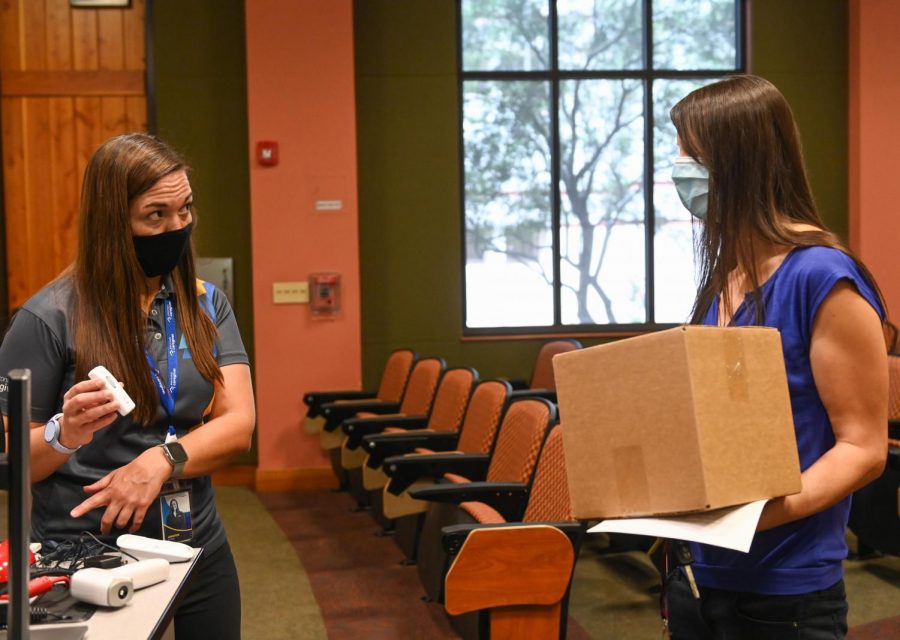NMSU, Electronic Caregiver launch project to evaluate COVID-19 monitoring system
A woman holding equipment speaks to another woman Jennifer Ross, left, of Electronic Caregiver, explains the equipment that Carol MacDonald, right, a nurse supervisor at the Aggie Health and Wellness Center at New Mexico State University, will use to participate in a project to evaluate an automated telehealth system that monitors COVID-19 symptoms. (NMSU photo by Josh Bachman)
A team of public health researchers at New Mexico State University launched a demonstration project this summer in partnership with the Las Cruces-based Electronic Caregiver to evaluate the feasibility of an automated telehealth system that monitors COVID-19 symptoms.
Researchers from the NMSU College of Health and Services’ Department of Public Health Sciences will conduct the project over a six-month period, using a telehealth system developed by Electronic Caregiver called Premier. Professor Joe Tomaka will serve as the project director.
The project, part of NMSU’s commitment to providing a safe environment for learning and working amid the coronavirus pandemic and recovery, will include approximately 100 volunteer participants – 60 employees and 40 students – from the Las Cruces campus.
“We’re working with NMSU to provide our Employee Protection Program through our Premier device tailored toward a research model,” said Timothy Washburn, chief clinical officer for Electronic Caregiver.
“We are hoping to determine the extent to which people are able to complete a daily symptom monitoring routine, their level of comfort and satisfaction with the process, and the extent to which it helps people feel safe in their work environment.” Tomaka said.
All participants will receive the Premier telehealth system, a touchless temperature probe and a pulse oximeter. Premier is programmed to monitor COVID-19 symptoms and features a small electronic device known as the Premier Portable Safety system, which connects directly to Electronic Caregiver’s health-monitoring center and health-care providers.
Each morning, Premier will prompt all participants to report their temperature readings and oxygen-saturation levels and answer a series of COVID-19 symptom questions.
“Premier allows participants to self-report not only with temperature, which is standard with our Employee Protection Program, but also with the pulse oximeter,” Washburn said. “The science is telling us that one of the interesting first signs, and one of the ongoing ways to evaluate, is measurement of the pulse oximetry.”
After completing the daily self-reporting process on Premier, participants will receive a prompt of action based on their responses, giving them clearance to proceed with regular daily activities or alerting them to seek medical attention.
For example, if a participant reports one or fewer symptoms, an oxygen-saturation level of 92 percent or higher, and a normal temperature around 98.6 degrees, the system will inform the individual that they may proceed with either work or school.
But if a participant reports two or more symptoms, an oxygen-saturation level of less than 92 percent, and an abnormal temperature above 98.6 degrees, the system will inform the individual of potential concern and send an alert to the researchers overseeing the project. A student research assistant will then ask the person in question to seek further medical guidance and assessment with their primary care physician or the Aggie Health and Wellness Center.
Electronic Caregiver will store all data collected from participants in a company data center, following federal privacy laws restricting the release of medical information.
The project calls for limiting face-to-face contact between the researchers and each participant to one 60-minute session.
“This session will occur at the initiation of the project, where the research team will describe the project, obtain informed consent, distribute necessary equipment, and provide instructions for completing the remainder of the project,” Tomaka said. “Electronic Caregiver staff will also be present to assist with instruction and technical questions.”
Participants also will complete three 20-mintue online surveys over six months. The surveys will examine health status, symptom experience, attitudes toward COVID-19 prevention behaviors, work productivity, health-care engagement, well-being, workplace safety, and workplace concern.
Tomaka sees both individual and societal benefits in this project.
“Benefits to the individuals involved, students and staff alike, include enhanced monitoring of potential COVID-19 symptoms and immediate referral to medical assistance throughout the duration of the project,” he said. “Such monitoring may reduce the stress and anxiety created by working in an uncertain environment during the COVID-19 pandemic.”
He added, “The possibility of creating smarter, safer ways for individuals to return to work and school during a pandemic is also a benefit on the societal level.”
In response to the pandemic, Washburn said, more and more companies are selling COVID-19-related technology, but few are engaging in research projects to find answers to critical questions.
“In this case, not just about seeing if there’s a change in incidence,” he said. “We are going to be asking how the employee or student feels about having this equipment. Does it make them feel more comfortable knowing they are prescreened and they have access to medical consult from home at any time?”
For more information about the project, contact Tomaka at [email protected].

